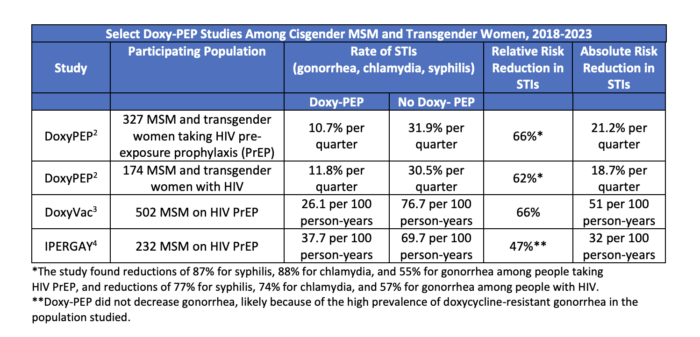NYC health officials, doctors embracing doxy-PEP for STI prevention
Since early last year, patients visiting Dr. Archie Jao’s Brooklyn clinic have been asking him about a new approach to preventing some STI infections. Known as doxy-PEP, a form of post-exposure prophylactic (PEP), the treatment involves taking 200 milligrams of the antibiotic drug doxycycline ideally within 24 and up to 72 hours after having a … Read More

Since early last year, patients visiting Dr. Archie Jao’s Brooklyn clinic have been asking him about a new approach to preventing some STI infections.
Known as doxy-PEP, a form of post-exposure prophylactic (PEP), the treatment involves taking 200 milligrams of the antibiotic drug doxycycline ideally within 24 and up to 72 hours after having a potential exposure. Studies have shown it can reduce the likelihood of infection from the sexually-transmitted infections (STIs) chlamydia, syphilis, and gonorrhea.
With STI infections on the rise locally and across the country, some healthcare professionals are encouraged by doxy-PEP’s potential to curb the spread. According to 2021 data from the Centers for Disease Control and Prevention (CDC) data, syphilis cases have increased by 74% since 2017, while gonorrhea went up by 28%. In New York City, chlamydia rates among men climbed by 13.2% between 2020 and 2021, while gonorrhea rates saw a 12.9% uptick.
Jao, who serves as medical director at Housing Works’ East New York health clinic, has witnessed an increase in patients exposed to chlamydia, syphilis, and gonorrhea visiting his clinic.
In October, the CDC released draft guidelines recommending the use of doxy-PEP for men who have sex with men and transgender women who were exposed to a bacterial STI in the past year. In November, the New York City Department of Health sent a letter to healthcare providers recommending doxy-PEP to prevent bacterial STIs, joining other jurisdictions such as San Francisco.

But some doctors already had a head start. Jao said he has been prescribing doxy-PEP for patients since the middle of last year after thoroughly researching it and receiving encouragement from queer patients who had started to inquire about it.
“The LGBTQ community particularly has sort of spearheaded this, and asked us nicely, ‘When are you going to start doing this?’” Jao said. “It seems to be coming more from them than us, even though we try to do our best to educate them.”
Ovalle Quiros, an HIV prevention navigator at Community Health Action of Staten Island, has also noticed that knowledge of doxy-PEP has spread quickly throughout the community, which he suspects could be due to social media.
Quiros takes doxy-PEP himself.
“I like to have fun too, and not have that worry in the back of my mind that, OK, is this bump from that?” he said. “I have had an STI before and I never want to catch another one again.”
What is doxy and who should take it?
A study published in May 2023 conducted in San Francisco and Seattle on men who have sex with men and trans women who had a bacterial STI in the past year found that doxy-PEP led to an 87% reduction in syphilis infections, 88% for chlamydia and 55% for gonorrhea for people taking HIV PrEP; and slightly lower levels of reduction for people with HIV.

While the CDC’s preliminary guidelines recommend doxy-PEP specifically for people who have had a previous infection, the NYC Health Department’s recommendations say to “consider prescribing doxy-PEP on an episodic basis for patients who anticipate periods when their STI risk may be higher.”
Regardless of their medical history, Jao said, “if patients and especially patients who are at risk are coming to me asking for doxy-PEP, I’m probably going to give them doxy-PEP.”
Dr. Preeti Pathela, the executive director of the NYC Health Department’s Sexually Transmitted Infections program, said people who already taking PrEP as well as those living with HIV are priority groups for doxy-PEP.
“These folks are already linked into healthcare in that they are coming for regular visits for HIV PrEP,” Pathela said. “So having the conversation about doxy-PEP for the prevention of other STIs is one that’s kind of a natural transition to make and can be done at the same time.”
The drug doxycycline is commonly prescribed to treat a variety of purposes, Pathela said, ranging from acne, to lyme disease, to syphilis. “We know that it’s such a common drug; it’s readily available at pharmacies,” she said.
It’s also relatively low-cost, and “not something that you’re going to have to jump through hoops with the insurance agency,” added Emilie Tippins of the Community Health Action of Staten Island.
The recommended dosage of doxy-PEP is 200 milligrams, which is prescribed as two 100 milligram pills taken at once. Jao said he typically prescribes a three-to-seven-day supply to patients, meaning six to 14 pills.
Dr. Jao encourages people not to become complacent when taking doxy. “It’s not like PrEP where it’s almost 100% risk reduction,” he said. He tells people that it should be considered one part of a “toolbox” for preventing STIs, and that they should visit him to get tested after taking it. It also does not prevent other STIs, such as herpes or trichomoniasis.
Risk of antibiotic resistance
In its letter to providers, the NYC Health Department notes that “doxy-PEP could lead to increased antibiotic resistance, with the risk varying by bacteria.” Doxycycline is already resistant to gonorrhea in other parts of the world, and some medical professionals are concerned that other STIs could develop resistance as well.
“In general, infectious disease doctors are cautious about long-term use of antibiotics to prevent infections,” said Martin Backer, a clinical assistant professor of medicine and infectious diseases specialist at NYU Langone Hospital–Long Island. “The concern is that if there’s still ongoing exposure, we can select for a strain that’s resistant and all of a sudden has a competitive advantage.” At the same time, Backer added that if there is less infection circulating, people are going to be less likely to transmit the STIs.
It’s important to balance treatment with prevention in order to minimize antibiotic resistance, said Dr. Pathela.
“In the end, using doxy-PEP isn’t a choice between antibiotics and no antibiotics because some people who don’t take doxy-PEP after an exposure to an STI end up contracting an STI and they would need an antibiotic for treatment,” she said. Ultimately that treatment could mean taking a greater amount of antibiotics than taking preventative doxycycline to begin with.
Where to get doxy-PEP in NYC
Anyone considering taking doxy-PEP is encouraged to consult with their doctor.
Many primary care physicians are already prescribing doxy-PEP. LGBTQ community health clinics, such as Callen-Lorde and Housing Works’ community health centers, also prescribe it.
Doxy-PEP is not currently available at NYC’s low-to-no-cost sexual health clinics, although the service will be rolled out this spring, Dr. Pathela said. Two of the city’s clinics – in Chelsea and Fort Greene – offer rapid testing for chlamydia and gonorrhea.
While doxy can be taken up to 72 hours after an exposure, Dr. Jao said it’s best to get it as soon as possible.
“Make the call, and persist,” he said. “I’m talking like the same-day. So many things could happen within those 72 hours.”
You can learn more about doxy-PEP from the NYC Health Department’s fact sheet and infographic.

 Mark
Mark 





